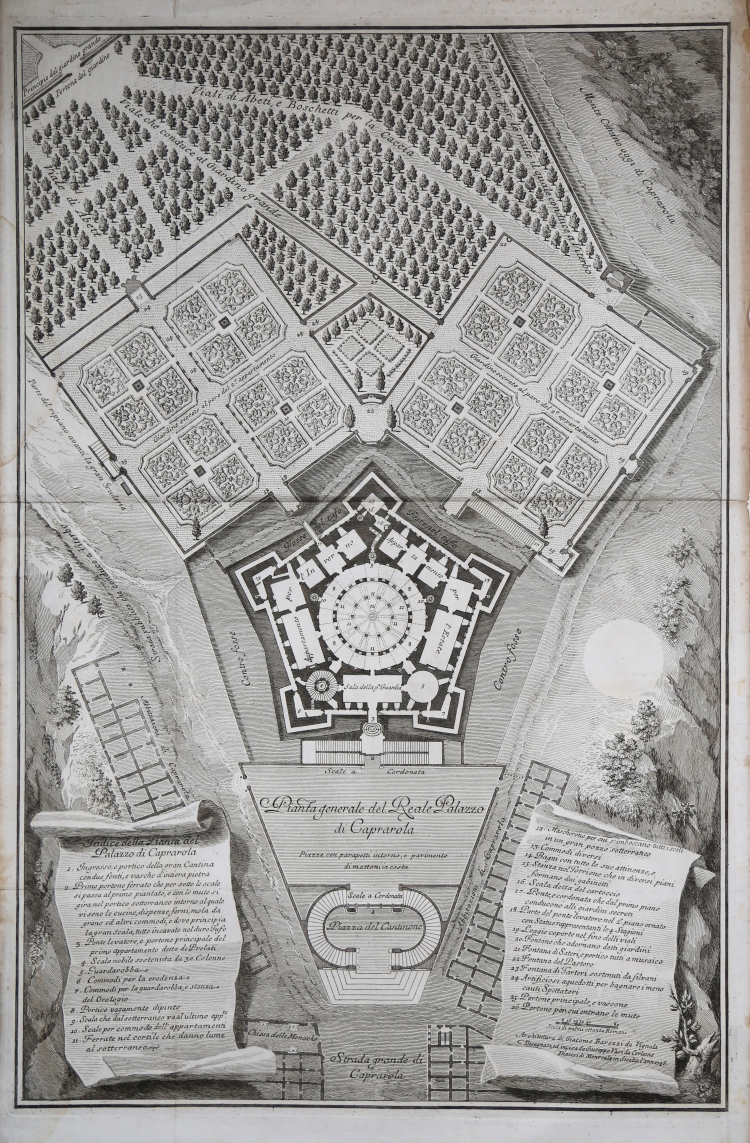



| Reference: | CO-951 |
| Author | Giuseppe VASI |
| Year: | 1746 |
| Zone: | Caprarola |
| Printed: | Rome |
| Measures: | 480 x 730 mm |


| Reference: | CO-951 |
| Author | Giuseppe VASI |
| Year: | 1746 |
| Zone: | Caprarola |
| Printed: | Rome |
| Measures: | 480 x 730 mm |
Beautiful map of the palazzo and the gardens Farnese of Caprarola, published in the work Illustri fatti farnesiani coloriti nel Real Palazzo di Caprarola dai fratelli Taddeo Federico e Ottaviano Zuccari... edita nel 1748, by George Kaspar de Prenner, published in 1748. The work illustrates, through the engravings by de Prenner, the decorations made by Taddeo and Ottaviano Zuccari in the palace. The five final tables, not numbered, were designed and engraved by Giuseppe Vasi and consist of views and plans of the palazzo Caprarola.
Here is the description of the Palace that Vasi himself gives in his "Indice istorico del gran prospetto di Roma... da Giuseppe Vasi: ovvero itinerario istruttivo per ritrovare con facilità tutte le antiche e moderne magnificenze di Roma, con una breve digressione-sopra alcune Città e Castelli Suburbani" printed in Rome in 1765 by Marco Pagliarini.
Sarebbe un errore se, avendo dimostrato le magnificenze antiche e moderne di Roma e suoi contorni, non guidassi ora il mio Lettore a vedere il celebre palazzo fatto erigere dal Card. Alessandro Farnese nipote di Paolo III. (...) Giacomo Barozio da Vignola ne fece il disegno in figura pentagona, con baluardi e fosse d'intorno a modo di fortezza, facendo nobilissimo invito una doppia cordonata alla magnifica piazza, e delizioso ing-resso al superbo palazzo una scala a due branchi con ponte levatore; ed altra nobilissima e maravigliosa scala fatta a chiocciola con colonne doriche e balaustri, lavorata sì perfettamente, che sembra tutta di getto; con un cortile sferico cinto di portici e di logge. Tanto le camere e sale del primo piano nobile, quanto quelle del secondo, i portici, le logge e le scale, sono tutte a volta, ornate di vaghissimi stucchi e capricciose pitture a grottesco fatte dal famoso Antonio Tempesta. Nelli sfondi delle camere e delle sale sono dipinte varie favole proposte da Annibal Caro a Taddeo e Federigo Zuccheri, i quali dipinsero ancora alcuni fatti celebri de' Farnesi che il Card. Trajano Acquaviva fece incidere in rame, ed insieme le piante e alzate dell'edificio, per compiacere gli eruditi dilettanti. Alla magnificenza del palazzo corrisponde l'amenità di due giardini segreti, ai quali si passa per due ponti levatori; ed ancora la delizia di una villa con amenissimi viali, boschetti e diversità di fontane, di scale e fiorire ornate di sculture capricciosissime; e con un casino di ricreazione posto fra' due giardini si rende oltre modo riguardevole questa delizia, ora del mio Sovrano il Re delle due Sicilie.
Etching, printed on contemporary laid paper, repairs at the lower margin, otherwise good condition.
Giuseppe VASI (Corleone, 27 Agosto 1710 - Roma, 16 Aprile 1782)
|
Italian engraver and painter. After completing a classical education, he trained as a printmaker in Palermo, possibly at the Collegio Carolino, which was founded by the Jesuit Order in 1728 and at which the etcher Francesco Ciché ( fl before 1707; d Palermo, 1742) was a teacher. Vasi was already an accomplished engraver when, in 1736, he contributed to the illustration of La reggia in trionfo by Pietro La Placa, which described the festivities held in Palermo to mark the coronation of Charles VII of Naples (the future Charles III of Spain). That same year Vasi moved to Rome, where, as a Neapolitan subject, he was immediately afforded the protection of the ambassador, Cardinal Troiano Aquaviva d’Aragona (1694–1747). In Rome he met other artists who worked for the same patron: Sebastiano Conca, Luigi Vanvitelli and Ferdinando Fuga. It is against this background that Vasi’s work in Rome, when he was in residence at the Palazzo Farnese, should be considered: his monopoly as the engraver of the Roman records of the monarch, the plates for the festivals of the ‘Chinea’ and the triumphal arches erected in front of the Palatine gardens on the occasion of temporal sovereignty over Rome
|
Giuseppe VASI (Corleone, 27 Agosto 1710 - Roma, 16 Aprile 1782)
|
Italian engraver and painter. After completing a classical education, he trained as a printmaker in Palermo, possibly at the Collegio Carolino, which was founded by the Jesuit Order in 1728 and at which the etcher Francesco Ciché ( fl before 1707; d Palermo, 1742) was a teacher. Vasi was already an accomplished engraver when, in 1736, he contributed to the illustration of La reggia in trionfo by Pietro La Placa, which described the festivities held in Palermo to mark the coronation of Charles VII of Naples (the future Charles III of Spain). That same year Vasi moved to Rome, where, as a Neapolitan subject, he was immediately afforded the protection of the ambassador, Cardinal Troiano Aquaviva d’Aragona (1694–1747). In Rome he met other artists who worked for the same patron: Sebastiano Conca, Luigi Vanvitelli and Ferdinando Fuga. It is against this background that Vasi’s work in Rome, when he was in residence at the Palazzo Farnese, should be considered: his monopoly as the engraver of the Roman records of the monarch, the plates for the festivals of the ‘Chinea’ and the triumphal arches erected in front of the Palatine gardens on the occasion of temporal sovereignty over Rome
|